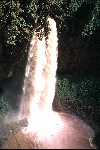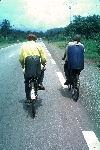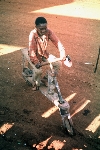|
 Along
with its other shortcoming Bafoussam seems to have a dearth of restaurants.
When we found this doll house size restaurant we decided we had better go with
it.
Because of the pink theme we named this the Barbie Restaurant. Despite our
sarcasm them whipped up and excellent omelet, bread and coffee/tea/hot chocolate
breakfast. Along
with its other shortcoming Bafoussam seems to have a dearth of restaurants.
When we found this doll house size restaurant we decided we had better go with
it.
Because of the pink theme we named this the Barbie Restaurant. Despite our
sarcasm them whipped up and excellent omelet, bread and coffee/tea/hot chocolate
breakfast.
From Bafoussam started heading back to the coast. If you are not in a
hurry, it is a
two day bicycle ride to Nkongsamba. There are two routes to choose from;
one by the
old highway with an overnight in Bafang, and the other via the new highway with
an overnight in Dschang.
 The
new highway is a toll road with toll boths. Tolls seemed to be less than a
dollar for cars and bicycles pay nothing. Unlike most other places there
was no sign showing the tolls for different vehicles. But there is a big
sign next to the toll booth about fighting AIDS. Unlike the police check
points, when a toll is paid the driver receives a receipt. The
new highway is a toll road with toll boths. Tolls seemed to be less than a
dollar for cars and bicycles pay nothing. Unlike most other places there
was no sign showing the tolls for different vehicles. But there is a big
sign next to the toll booth about fighting AIDS. Unlike the police check
points, when a toll is paid the driver receives a receipt.

The highlands around Dschang have a relatively unique climate for Cameroon so
you see some crops in the area that you won't see elsewhere in the country.
To the left is a vineyard. It wasn't clear if the grapes were intended for
the table or to be made into wine. Not far from here is one of the few
areas in Cameroon where they grow tea.
 It is curious how many very large houses there are along this section of road, a
lot of them only partially finished. There doesn't seem to be enough
economic activity in the immediate area to pay for this kind of construction so
we pondered the dynamic. The Bamileke are know for there acumen for
entrepreneurial activities so may be the owners live and make there money
elsewhere and are investing it "back home." Alternatively, there area is
know for its nice climate so maybe wealthy people from other parts of the
country are building "vacation villas" here to escape to during the hot season
wherever their permanent residence is. And then there are the real facts,
which are yet to be determined.
It is curious how many very large houses there are along this section of road, a
lot of them only partially finished. There doesn't seem to be enough
economic activity in the immediate area to pay for this kind of construction so
we pondered the dynamic. The Bamileke are know for there acumen for
entrepreneurial activities so may be the owners live and make there money
elsewhere and are investing it "back home." Alternatively, there area is
know for its nice climate so maybe wealthy people from other parts of the
country are building "vacation villas" here to escape to during the hot season
wherever their permanent residence is. And then there are the real facts,
which are yet to be determined.


 At almost every town along the road their was a sign for a chieftaincy or
sub-chieftaincy. Where we could see the compound they didn't disappoint us
and had some elements of the traditional Bamileke architecture.
At almost every town along the road their was a sign for a chieftaincy or
sub-chieftaincy. Where we could see the compound they didn't disappoint us
and had some elements of the traditional Bamileke architecture.
  Needless
to say it is a beautiful road with plenty to look at and ponder. Not
having previously taken a picture of an onion patch on this trip, I decided to
correct that omission in my collection with the picture on the right. Needless
to say it is a beautiful road with plenty to look at and ponder. Not
having previously taken a picture of an onion patch on this trip, I decided to
correct that omission in my collection with the picture on the right.
 In
Balessing, we stopped for refreshments, which provided an opportunity to fill in
some gaps on the language research project. Coming out of Bafoussam the
language is Mungaka (Narrow Grassfields>Mbam-Nkam>Nun). Most of the other languages
the area are
Narrow Grassfields>Mbam-Nkam>Bamileke. North of Balessing, from Penka-Michel
to Mbouda the language is Ngiemboon. Around Balessing the language is Ghomálá'. South of Balessing, around Dschang,
the main indigenous language is Yemba. In
Balessing, we stopped for refreshments, which provided an opportunity to fill in
some gaps on the language research project. Coming out of Bafoussam the
language is Mungaka (Narrow Grassfields>Mbam-Nkam>Nun). Most of the other languages
the area are
Narrow Grassfields>Mbam-Nkam>Bamileke. North of Balessing, from Penka-Michel
to Mbouda the language is Ngiemboon. Around Balessing the language is Ghomálá'. South of Balessing, around Dschang,
the main indigenous language is Yemba.
 There is a cliché about pretty university towns, but Dschange is a pretty
university town. It is set on rolling hills among higher hills, with a lot
of trees in the town center. The university is on the edge of town, on one
of the higher hill. Most of the students find housing down in the town so
in the morning and afternoon there are streams of students connecting the two.
There is a cliché about pretty university towns, but Dschange is a pretty
university town. It is set on rolling hills among higher hills, with a lot
of trees in the town center. The university is on the edge of town, on one
of the higher hill. Most of the students find housing down in the town so
in the morning and afternoon there are streams of students connecting the two.
 Our
hosts in Dschang were professors at the University of Dschang. Fai and
Martin are both theoretical physicists. Both had studied in Cameroon and
internationally. Now they lecture about and do research on sub-atomic
particles at the university. The conversation with them on sub-atomic, juxtaposed to most of the rest of the economy
we had been experiencing for the last week, took some exercise for the mind to fit
the two
together. Our
hosts in Dschang were professors at the University of Dschang. Fai and
Martin are both theoretical physicists. Both had studied in Cameroon and
internationally. Now they lecture about and do research on sub-atomic
particles at the university. The conversation with them on sub-atomic, juxtaposed to most of the rest of the economy
we had been experiencing for the last week, took some exercise for the mind to fit
the two
together.
 It
was with some irony that we saw this mural on pesticide application in town.
Earlier in the afternoon we had been talking to a professor and research chemist
at the university who was doing research on pesticide toxicity in Cameroon. It
was with some irony that we saw this mural on pesticide application in town.
Earlier in the afternoon we had been talking to a professor and research chemist
at the university who was doing research on pesticide toxicity in Cameroon.
Another chemist we met was studying the active chemical in traditional medical
plants that were used to treat diabetes. It would have been interesting to
have been able to meet more of the faculty and learn their research and its
applications to Cameroon.
Bafoussam‑BAFANG (56km, 35 mi) Down the Nkam River Valley and out of the
hills.
Points of interest: coffee farms, waterfall 2 miles before Bafang
Cycling conditions: paved, mountainous, then flat, then more hills.
 The
alternative route to the coast is the old highway. The road is not in as good
condition as the new road and in many place has reverted to dirt, but it is very
beautiful and culturally interesting. The
alternative route to the coast is the old highway. The road is not in as good
condition as the new road and in many place has reverted to dirt, but it is very
beautiful and culturally interesting.




In many of the villages there is the distinctive Bamileke architecture.
The most impressive is the chieftaincy in Bafang.

The road right-of-way is used by more that just vehicles. Another group of
frequent travelers are Fulani herders and their cattle that they are walking to
market. For a lot of the route there are trails for the cattle that
parallel the road. Another sign of the transit activity is the frame for a
temporary shelter and a fire pit.

It is hard to know if it is impromptu or planned, but it was nice to see this
wood fence doing double duty as a bicycle rack. The bicycles are all blue,
one-speed Peugeots or knock-offs of this Francophone West Africa standard.
  Plenty
of nature beauty is provided by adjacent mountains, the Col de Bati (a pass
through the hills) and some tall, thick, pounding waterfalls and their emerald
green glens. Plenty
of nature beauty is provided by adjacent mountains, the Col de Bati (a pass
through the hills) and some tall, thick, pounding waterfalls and their emerald
green glens.
|



























 Please
contact us
Please
contact us